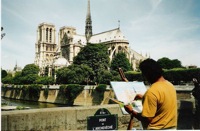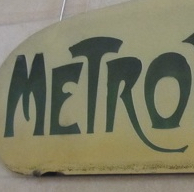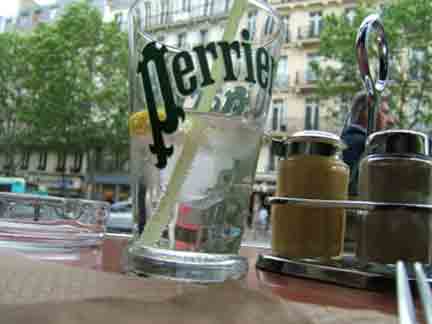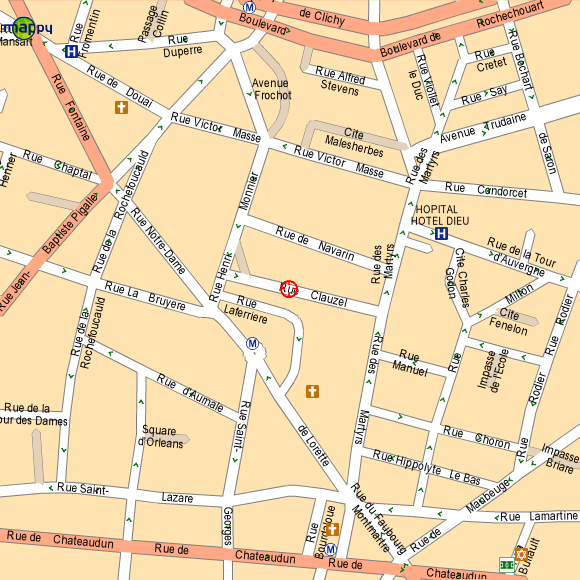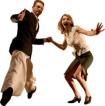First Things First
Before you leave home
A few things you need to know about before you have your first croissant:
 Money and paying for things. No problem. Virtually anyplace you go will take your credit card, but you might be asked to enter your PIN. Most Americans, as far as Tom can tell, have no idea what the PIN is on their credit cards (but they know the PIN on their debit cards). Typically, the point-of-sale software will recognize your card as foreign and the transaction will just go through. On rare occasion, however, you might be asked for a signature (generally speaking you're not, because the software expects people to enter a PIN). In most transactions you'll just tap the card on the contactless hotspot on the screen you're dealing with. However, if it's for something more than 75 euros, the transaction might get rejected (because of no PIN), in which case you merely insert the card into the terminal as in the olden days. If you have a payment system set up on your phone (e.g., Apple Pay), that will work, too.
Money and paying for things. No problem. Virtually anyplace you go will take your credit card, but you might be asked to enter your PIN. Most Americans, as far as Tom can tell, have no idea what the PIN is on their credit cards (but they know the PIN on their debit cards). Typically, the point-of-sale software will recognize your card as foreign and the transaction will just go through. On rare occasion, however, you might be asked for a signature (generally speaking you're not, because the software expects people to enter a PIN). In most transactions you'll just tap the card on the contactless hotspot on the screen you're dealing with. However, if it's for something more than 75 euros, the transaction might get rejected (because of no PIN), in which case you merely insert the card into the terminal as in the olden days. If you have a payment system set up on your phone (e.g., Apple Pay), that will work, too.
- You realize your ATM card will work in the cash machines here, right? You'll get euros right out of your bank account, deducted at the day's
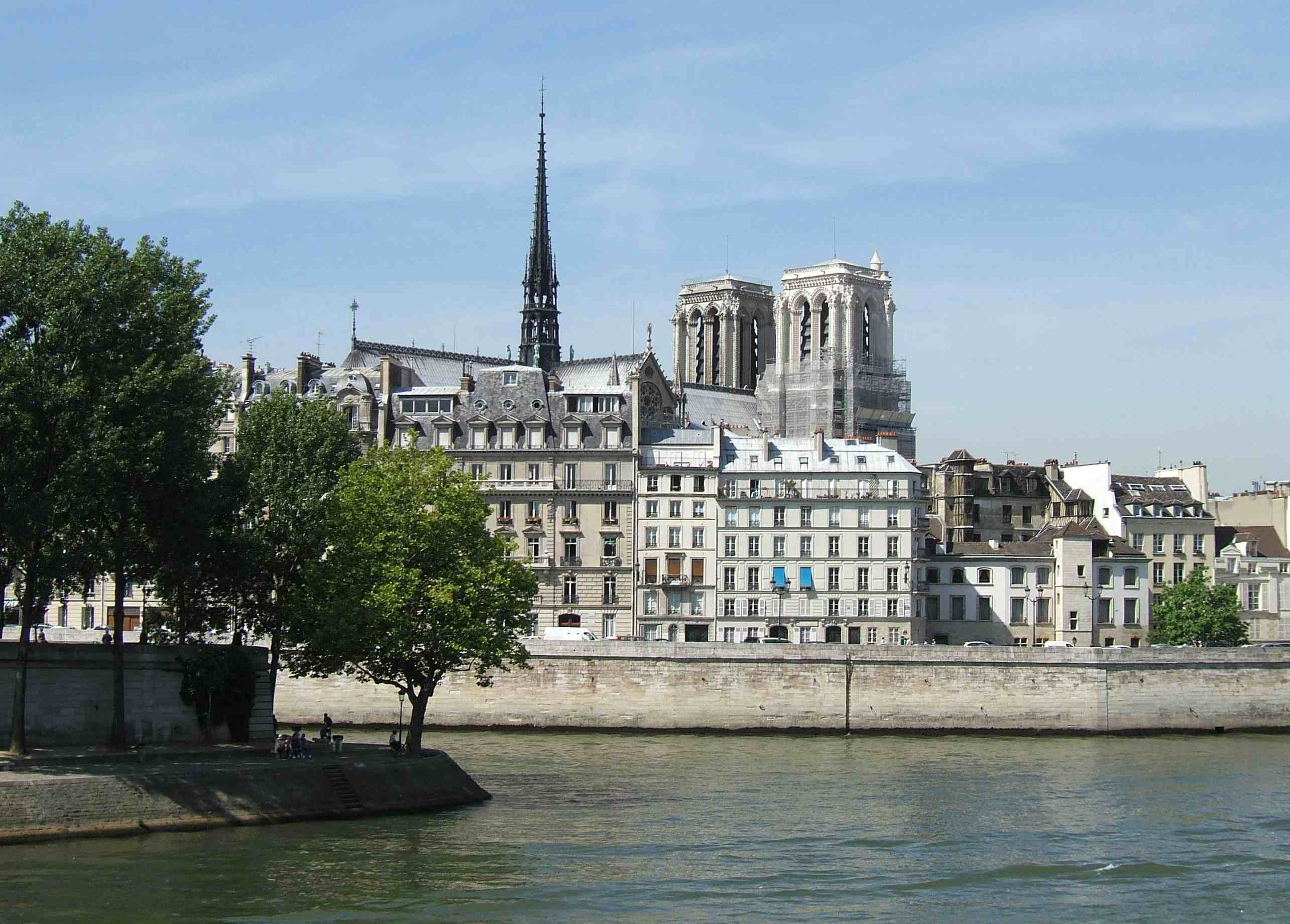 official exchange rate (plus whatever annoying service charge your blood-sucking bank charges). There are ATM machines in the airport, of course, so you can avoid changing money with those vultures who charge outrageous fees. If you're flying to CDG from the US on a major carrier, you'll find a very convenient ATM right where you exit into the main terminal after baggage claim: when you walk through the little maze (you'll see what I mean) head a little to your right and you'll find an ATM at porte 8, which is also where the taxi stand is. Oddly, this is one of the few ATM's in Paris where there's generally either no one using it, or maybe only one person. And BTW, it's not a bad idea to tell your bank you're going to be in Europe—a friend once had his card shut down because his overly cautious bank was worried about unusual transactions appearing on his account. Don't panic if your card doesn't work in a given machine: sometimes the machines are picky. Remove it and try another machine. Bank machines are everywhere in Paris.
official exchange rate (plus whatever annoying service charge your blood-sucking bank charges). There are ATM machines in the airport, of course, so you can avoid changing money with those vultures who charge outrageous fees. If you're flying to CDG from the US on a major carrier, you'll find a very convenient ATM right where you exit into the main terminal after baggage claim: when you walk through the little maze (you'll see what I mean) head a little to your right and you'll find an ATM at porte 8, which is also where the taxi stand is. Oddly, this is one of the few ATM's in Paris where there's generally either no one using it, or maybe only one person. And BTW, it's not a bad idea to tell your bank you're going to be in Europe—a friend once had his card shut down because his overly cautious bank was worried about unusual transactions appearing on his account. Don't panic if your card doesn't work in a given machine: sometimes the machines are picky. Remove it and try another machine. Bank machines are everywhere in Paris.
Make a photocopy of your passport and keep it with you.
- Remember that Western Europe uses 220 volt electricity—if you must bring small appliances with you, get an adaptor, and remember to get the prongs that will fit French outlets (ask or go on line at Best Buy, Target, or some such place). Your laptop and your phone will adapt by themselves, but you'll still need the prongs to fit over the plug so that it will fit in the French outlets. If you forget, they're easy to find here: the word is adaptateur, and if you're near the center of the city, the BHV (Bazar de l'Hotel de Ville) has a ton of them. Your hotel might even have them, but I wouldn't count on it. Also, some newer hotels and some of the more expensive hotels have outlets that will accept American plugs.
- Make a photocopy of your passport and keep it someplace with you where you don't keep your passport. Better yet, scan the appropriate pages of your passport, and then email the image to yourself. That way, you can access the information, including your passport photo, anywhere in the world (cool idea, huh?). (However, you should recognize that although it's very unlikely, someone could intercept the email scan of your passport, just as someone could get the number of your passport by looking over your shoulder at customs.)
- Do all you international types know about Global Entry? If you travel internationally with any regularity at all, this is certainly worth it, and you get TSA pre-check with it automatically. You can get through US customs in most airports in 90 seconds or less (in my experience).
- Remember to get your shots (just kidding: where do you think you're going, anyway?)
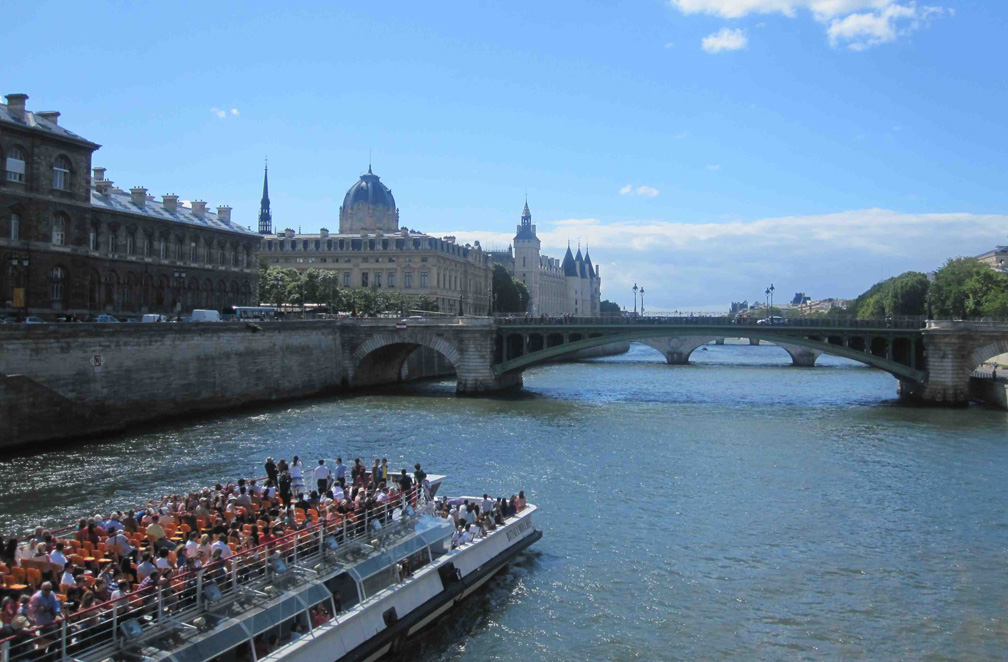 You will have checked with your cell phone service provider about how (or if) your phone works abroad. Different carriers work differently, and some are better than others abroad. Some will sell you a short-term data package for your time abroad. There's also more and more free wifi in Paris, so with a little ingenuity you can be connected all the time. More and more, most cell plans provide you access to 2 or 3G networks automatically, but if you want 4 or 5G you have to pay a premium for some limited amount of data. Check with your carrier. Also be advised that it's not that completely uncommon to be unable to access the cellular network from an American carrier for short or extended periods of time.
You will have checked with your cell phone service provider about how (or if) your phone works abroad. Different carriers work differently, and some are better than others abroad. Some will sell you a short-term data package for your time abroad. There's also more and more free wifi in Paris, so with a little ingenuity you can be connected all the time. More and more, most cell plans provide you access to 2 or 3G networks automatically, but if you want 4 or 5G you have to pay a premium for some limited amount of data. Check with your carrier. Also be advised that it's not that completely uncommon to be unable to access the cellular network from an American carrier for short or extended periods of time.
By the way, did you know that French land lines can call pretty much any other land line anywhere in the world and it's a local call?
How to know what's going on
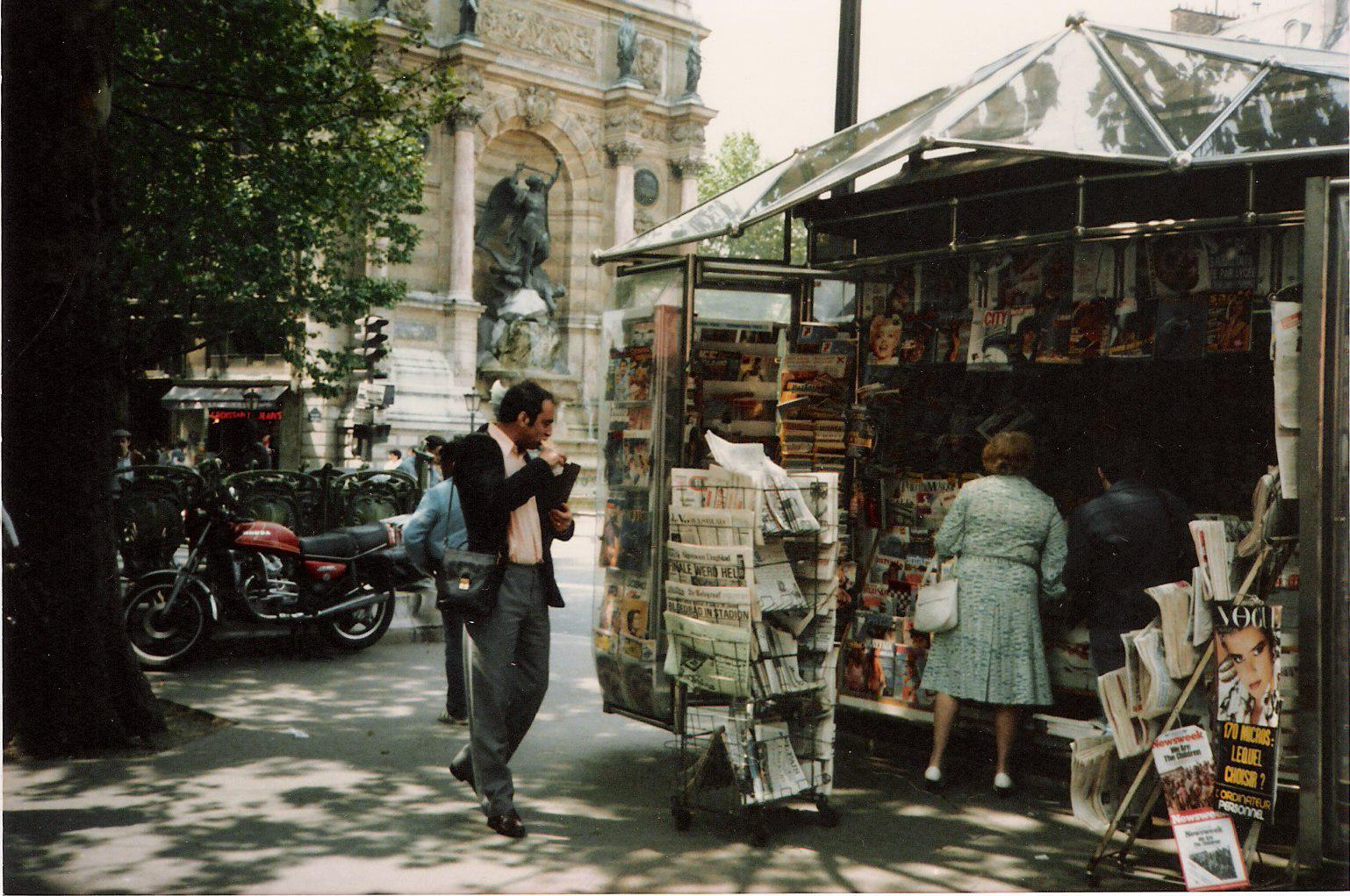
The best way to find out what's going on in the city—and that includes food, drink, movies, theatre, dance, special and seasonal events and more—is to stop at your local kiosk, situated all over every busy area of the city. You'll find all kinds of papers and magazines, some in English, that will keep you up-to-date on the latest goings on in the city. Tom's favorite online publication is " Paris je t'aime" (yeah, sorry about the name, but it's true). This site is operated by the Paris Convention and Visitors Bureau, and they do a pretty mean job of keeping up to date on absolutely everthing that's going on in the city. The website is nicely maintained, you can get a lot of info about current events, and they'll even give you food recommendations. Don't expect it to be as good as the info in Tom's Guide, but, hey—they try.
Getting into the city from the airport
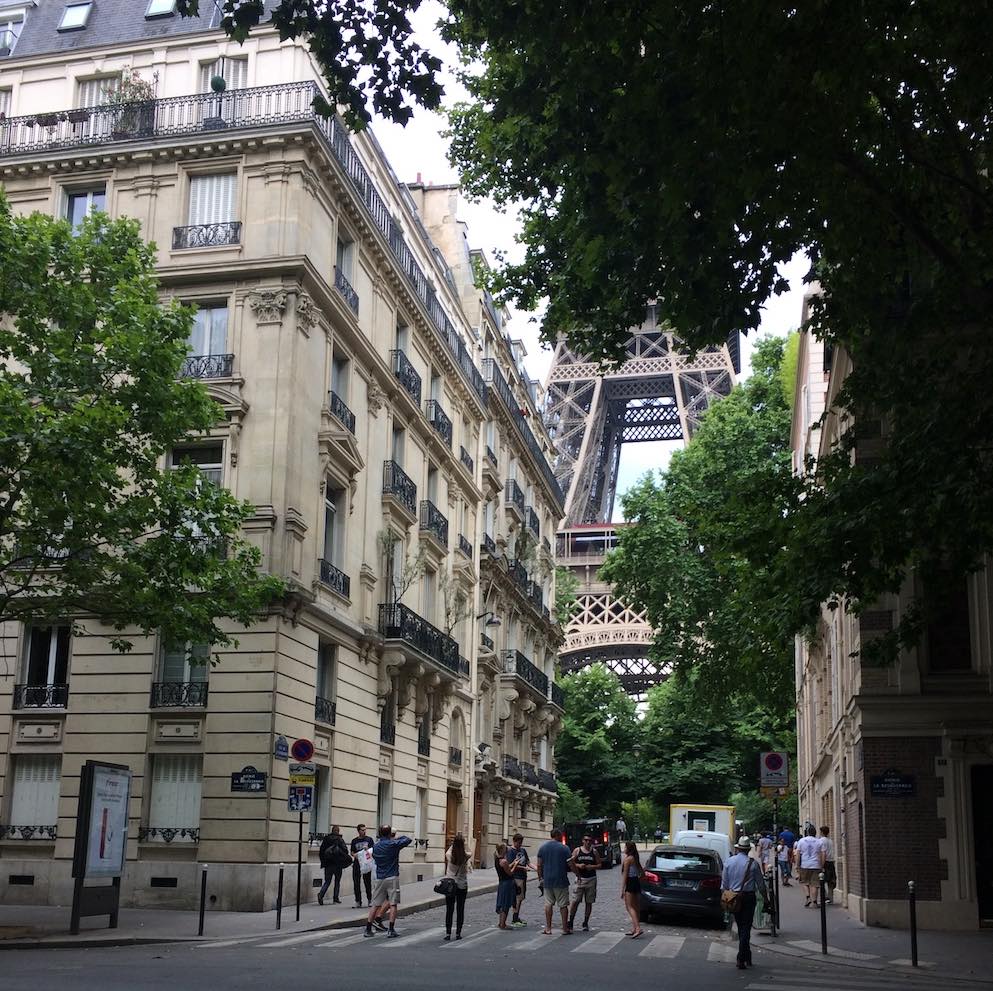
Taxis from any of the airports are always available, of course, and while taxis charge a metered rate within the city, they have a flat-rate charge of 58 euros for heading to the left bank and 53 euros for going to the right bank. Those are the rates from CDG. Orly, which most of you won't use, doesn't advertise its taxi rates into the city, but they're pretty similar.
If you're feeling adventurous and/or would like to save a few euros, you might want to take the RER (which stands for réseau express régional, or "regional express network"), which will get you into the city in about 40-50 minutes, depending on the train (express or local) you're on. Tom's record from the plane touching down on the runway to his apartment in Paris is 60 minutes. Beat that. (You should know, however, that if you travel with a great deal of luggage, the RER might not be the best option for you, and if you have a difficult time with steps this might not be your best bet, either.) If you're in reasonable shape, are feeling a little game for a very slight adventure, and not over-burdened with luggage, this is your best bet.
Getting the RER From Charles De Gaulle (Roissy):
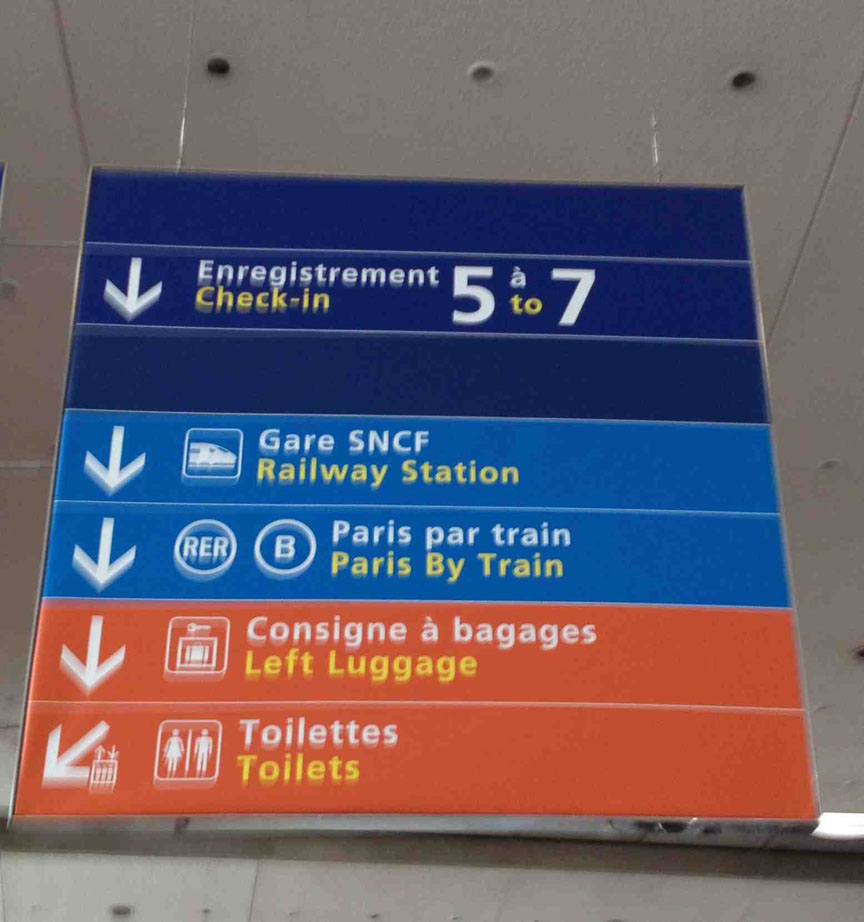 To take the RER, follow the signs such as those you see here for "Paris par train/ Paris by Train" with the symbol RER and the letter "B" in a circle (B is the name of the line you're going to take) or ask directions for the RER (which stands for Réseau Express Régional—the regional express network)—there are handy info booths in the airport everywhere, and the people who staff them are quite friendly. The RER is a fast and pleasant commuter railroad that runs into and through Paris like spokes on a wheel. When you get to the RER station, go to the green ticket machines and punch the button for a ticket to Paris (there's an option on screen for instructions in English). If you happen to
To take the RER, follow the signs such as those you see here for "Paris par train/ Paris by Train" with the symbol RER and the letter "B" in a circle (B is the name of the line you're going to take) or ask directions for the RER (which stands for Réseau Express Régional—the regional express network)—there are handy info booths in the airport everywhere, and the people who staff them are quite friendly. The RER is a fast and pleasant commuter railroad that runs into and through Paris like spokes on a wheel. When you get to the RER station, go to the green ticket machines and punch the button for a ticket to Paris (there's an option on screen for instructions in English). If you happen to 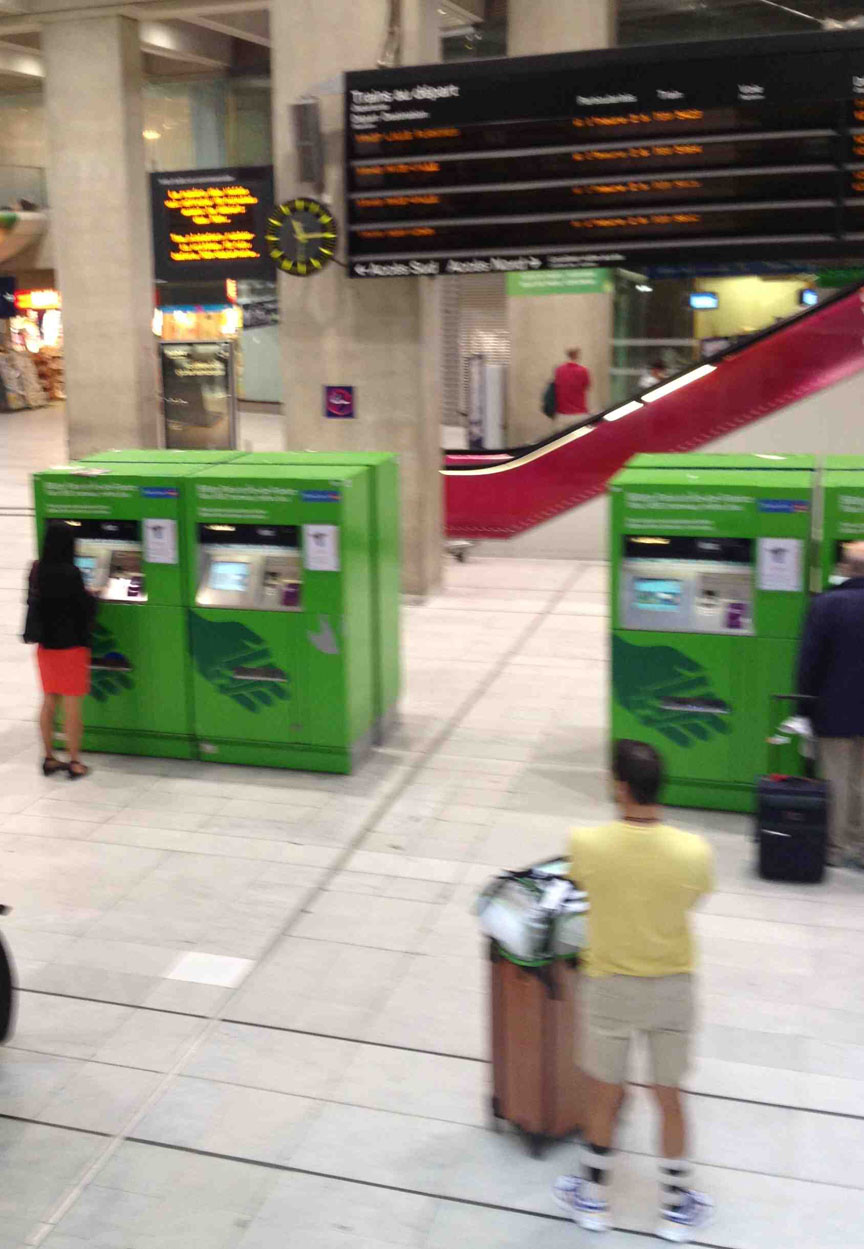 have Euro coins on you, they'll take those, too. Right now it's 11.80 euros to go from the airport to the city. If you find the machine won't take your card, try another. Often they're just moody.
have Euro coins on you, they'll take those, too. Right now it's 11.80 euros to go from the airport to the city. If you find the machine won't take your card, try another. Often they're just moody.
If for whatever reason you can’t get the machines to work— sometimes they just won't—you can simply stand in the short line at the ticket window off to the side, say "un billet pour Paris, s’il vous plaît" [unh beeyay poor Paree seel voo play], pony up 11.80 €, and you’re set. Here are some additiional instructions should you feel the need.
Now look for the signs that say RER off to the side (see the image above), and head over to the turnstiles (Tom thinks this word should be spelled "turnstyles.") Insert the ticket into the slot and make sure to take your ticket from the top of the machine. Hold on to it: you will need it to exit! (You'll put it through a similar turnstile when you exit the system. This is unique to the RER—you do not need your ticket to exit the metro.) You will also need it for the rare circumstance of having a conductor ask to see it. Now, clutching the ticket in your hot little hands, go down the escalator to the platorm. All the trains leaving from here go to Paris (and they even say so for disbelieving tourists), so you can’t get on the wrong one—just get on. There are roughly ten suburban stations before you reach Gare du Nord, the first RER stop in Paris. The RATP (Paris' transportation authority) has a good map that will help you keep track of where you are, and this same map will be above each door on the train. The stations within Paris are Gare du Nord; Châtelet–Les Halles; Saint-Michel–Notre Dame; Luxembourg; Port-Royal; Denfert-Rochereau; and Cité Universitaire.
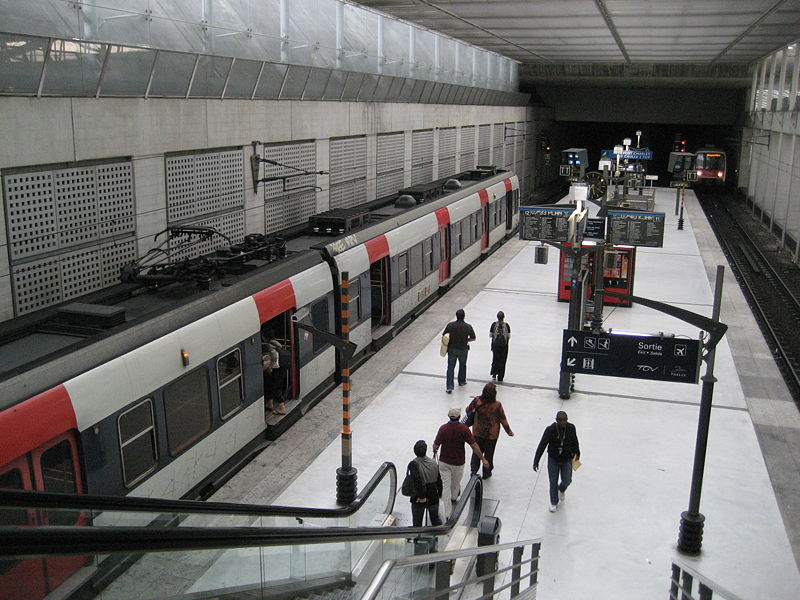 You will note that the scenery on the way into the city might not be what you expected—in fact, it's pretty bleak. If this is the case, you're a hopeless romantic, but you won't be disappointed when you get into town. Once you get into Paris, the RER connects directly to the métro, so you can simply change trains and go directly to your destination without even buying another ticket (although you will have to put the same ticket you used at the airport through the turnstile again, whether it's to exit the RER or to transfer to the metro—it's really obvious and you'll understand it as soon as you see it, mainly because everyone in front of you is doing it). You can click here for a mini lesson on how to use the metro. You will find the metro very easy to use, and there are signs everywhere, and if you aren’t sure where to go, you can ask someone and they’ll explain to you how to do it (really; all this nonsense about Parisians being rude simply escapes Tom).
You will note that the scenery on the way into the city might not be what you expected—in fact, it's pretty bleak. If this is the case, you're a hopeless romantic, but you won't be disappointed when you get into town. Once you get into Paris, the RER connects directly to the métro, so you can simply change trains and go directly to your destination without even buying another ticket (although you will have to put the same ticket you used at the airport through the turnstile again, whether it's to exit the RER or to transfer to the metro—it's really obvious and you'll understand it as soon as you see it, mainly because everyone in front of you is doing it). You can click here for a mini lesson on how to use the metro. You will find the metro very easy to use, and there are signs everywhere, and if you aren’t sure where to go, you can ask someone and they’ll explain to you how to do it (really; all this nonsense about Parisians being rude simply escapes Tom).
If you’re travelling at rush hour, taxis will definitely be significantly slower than public transportation.
Helmut reminds me that you can also take the RoissyBus, which is run by the RATP (which stands for "Régie Autonome des Transports Parisiens", and it's the Paris transportation network). It will take you from the airport to the Opéra, and from there you can grab other forms of public transportation anywhere. It's cheaper than a taxi (16.60 euros) and reasonably fast, depending on traffic (figure at least an hour, but probably more like an hour and a half). The last bus from the airport into the city is 11:00 pm; the first bus in the morning from Paris to the airport is at 5:45 am.
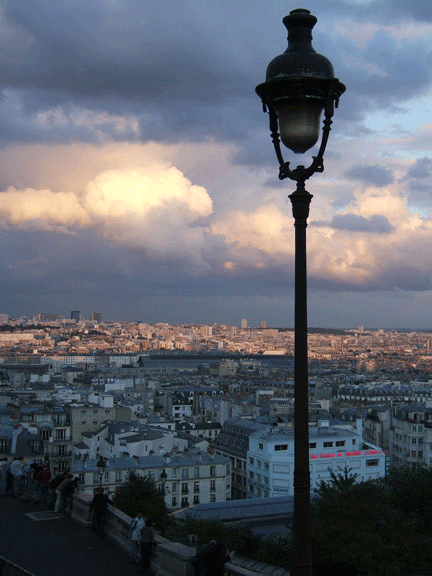 Taking the RER From Orly:
Taking the RER From Orly:
From Orly you're going to want to take RER line C from the Port de Rungis, and there's a little shuttle (navette) that will take you from the airport to the station. This should cost about 8 euros. You can also take the Air France bus, which will dump you off either at Montparnasse or Invalides (11.5 euros); or the Orlybus, which is run by the RATP, I think, and that'll take you to the Denfer-Rochereau metro/RER station. It runs between 6:00 am and 11:00pm, and costs 11.20 euros. It will take you to Denfert-Rochereau, Châtelet, and/or the Gare du Nord.
From Beauvais:
Ted points out that "If you should happen to fly RyanAir into Paris you'll be in Beauvais, which is nearly 80 km/50 mi outside the city. Best/cheapest way is the bus. It's cheaper than a cab!" You can't beat the 18 euro price. Info in English can be found here.
Knowing where you are
Write down the name and address of your hotel and keep it with you at all times.This will sound so obvious you'll think I'm crazy for putting it here, but let me tell you a little story and then you decide. Quite some time back I was walking home with a friend and it was very late at night—on the order of 2:30 am or so. We came across two young American women who were sobbing. We asked them what was wrong, and they said they didn't know where their hotel was. OK, no problem, we said, what's the address? "We don't know!" they sobbed. "What's the name of it?" The sobbing increased dramatically. They were so excited about being in Paris that they dumped their bags in their room and bolted out the door, into the night, and out into the city without the first idea where they were staying—they didn't even have their passports with them. After a lot of quizzing about what was in the vicinity of their hotel (a big arch, but not the Arc de Triomphe), we hailed a cab for them and directed the driver to what we figured was the appropriate neighborhood. I have no idea what ever happened to them.
The moral of this little cautionary tale? Write down the name and address of your hotel and keep it with you at all times!
